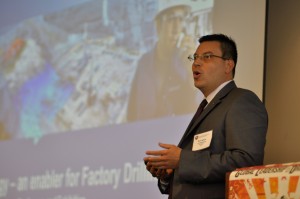Factory Drilling approach seeks to guarantee optimum outcome, each and every time
By Katie Mazerov, contributing editor

In today’s world of complicated and deviated wells, technology has gone a long way toward improving drilling optimization. Alongside the newest tools and methods, communication, coordination, alignment and consistency are important building blocks to achieving optimum rates of penetration (ROP). Speaking at IADC’s recent Advanced Rig Technology Conference & Exhibition in Houston, Ron Ayllon, Americas Rig Management Group, Schlumberger Integrated Project Management, presented a new way of thinking about drilling optimization.
The “Factory Drilling” approach for field development is a Schlumberger initiative that integrates the rig, well-site technology and a 24/7 remote operations monitoring center staffed by engineers using real-time data. The process brings to the oil and gas drilling industry the kind of factory, or automated, approach that has worked for decades in the automotive and aviation industries.
“Our goal in the industry is to drill and complete wells by using best available technology in the shortest time frame possible,” Mr Ayllon said. The typical drilling optimization process, he explained, is to achieve a learning curve, establish a benchmark, implement the technology with processes and then break down each process into several stages and try to optimize each one.
“We do attain improvements, but if we interrupt the campaign for any reason, we typically have to start over,” he said. “We have the process in place, but we struggle in many ways to be aligned and have consistent outcome. Each segment of the industry has its own goals, and those goals often differ. The goal should be to bring the oil or gas to production in the most efficient manner, all the time, every time.”
The challenge, he said, is to find a way to guarantee the same optimum outcome and to move beyond any interruption without starting over on a new learning curve, with new people, new systems and rigs, as this process can impact ROP and performance in terms of HSE.
“Ideally, we need the same people, using the same equipment, doing the same scope and consistently communicating and applying what they learn,” Mr Ayllon said. “Drilling automation is an enabler for us to reproduce our best performance through the consistent application of all our best practices and lessons learned. However, having access to the best people in the industry in the required quantities is not always possible.”
Factory Drilling offers an alternative to this limitation. The concept is based on optimizing the use of the best available resources while operating in a favorable drilling environment. It is best suited to high-volume operations with repeated well designs and known downhole risks and where the same fit-for-purpose rigs and drilling techniques are used, Mr Ayllon said. Typically, the fields are economically marginal and thus require high drilling efficiency. “Drilling optimization, where we can deploy the best resources and expertise, is the enabler,” he noted.
The concept has been deployed successfully for an 18-month project on a field in Poza Rica, Mexico. The operation involved deploying 12 fit-for-purpose rigs in a pad-based drilling operation. One person, from the drilling contractor, was in charge of the location, along with a rig safety coordinator. “Putting just one person in charge at the site limits decision-making conflicts,” Mr Ayllon noted.
The concept involved assigning three rigs under the supervision of a factory drilling supervisor in the 24/7 remote operations center, or factory drilling “cell.” The cell also was staffed with a directional drilling engineer, a well engineer and a senior well engineer, all monitoring the operation on personal computers using real-time data.
Third-party suppliers provided support and assistance when needed. “Being able to remove certain positions from the field site, such as well-site supervisor and directional driller, was only possible thanks to the available technology, real-time-data acquisition and monitoring, and the trust we put on the drilling contractor to safeguard the execution at the well site,” Mr Ayllon said.
This approach reduced the drilling time of wells while allowing a reduction in the number of employees. The average time to drill a well was reduced from 22 days to approximately seven to nine days. The average drilling rate increased from 6,000 meters per month to more than 10,000 meters per month.
Factory Drilling is a mark of Schlumberger
An expanded article on Factory Drilling will be published in the Nov/Dec 2011 issue of Drilling Contractor.




